Mick Rock (b 1948) captured some of rock's most provocative and memorable images: David Bowie at the height of his Ziggy Stardust androgyny; Debbie Harry looking every inch the Marilyn Monroe of punk; Lou Reed sweating beneath his Kabuki make-up - indeed, The Faces of Rock'n'Roll, as a new book surveying four decades of his photographs is titled.
Rock’s skill as a photographer and his extraordinary sense of timing - in more ways than one - is indisputable but what makes his pictures particularly striking is that Rock was no mere observer: he wasn’t just part of the scene, he helped to launch it. He was, as Lou Reed put it, “another leg of the animal called ‘rock’”. Because of his close association with musicians such as Bowie, Reed and Iggy Pop, Rock - and that really is the name he was born with - is known as "the man who shot the Seventies", but in fact he has worked prodigiously throughout the ensuing decades shooting everyone from Hall and Oates to Supergrass and The Prodigy. Some of the finest examples of his work have now been gathered together as part of Mick Rock: Music, a retrospective of Rock’s work at the Idea Generation Gallery and a new book, Exposed: the Faces of Rock'n’Roll. Both collections contain some old favourites such as Bowie and Mick Ronson tucking into a British Rail full English (pictured above, 1973) and plenty of new ones - but there are also some previously unpublished images and quite a few surprises.
Because of his close association with musicians such as Bowie, Reed and Iggy Pop, Rock - and that really is the name he was born with - is known as "the man who shot the Seventies", but in fact he has worked prodigiously throughout the ensuing decades shooting everyone from Hall and Oates to Supergrass and The Prodigy. Some of the finest examples of his work have now been gathered together as part of Mick Rock: Music, a retrospective of Rock’s work at the Idea Generation Gallery and a new book, Exposed: the Faces of Rock'n’Roll. Both collections contain some old favourites such as Bowie and Mick Ronson tucking into a British Rail full English (pictured above, 1973) and plenty of new ones - but there are also some previously unpublished images and quite a few surprises.
A couple of weeks ago I phoned Rock, who has lived in New York since 1977 but has retained his disarming rumbling west-London drawl, and he explained why he felt the time was right to cast an eye over the past four decades.
HILARY WHITNEY: I know you were born in west London but I know very little about your early life. Can you tell me something about it?
MICK ROCK: I don’t normally get into that particularly because I don’t think it’s necessary. But obviously, I went to Cambridge, that’s where it all began. I got a scholarship to Cambridge and turned out to be a very naughty boy.
 That’s how I met Syd Barrett (pictured left, 1971). He was from Cambridge although by the time I met him he was at Camberwell Art College and living in London. But I met these town's people and they said, "You must come and meet Syd, he’s playing at the Cambridge Arts College Christmas party." I didn’t know anyone who knew who Pink Floyd was – they were still underground when underground was really underground – although I gathered later they had played a few gigs in London. Anyway, I went to the Cambridge Arts College Christmas party and saw this amazing thing. You’ve got to remember, we’re talking – whoops-a-daisy – a lot of years ago now [1966], and so I met this extraordinary gentleman.
That’s how I met Syd Barrett (pictured left, 1971). He was from Cambridge although by the time I met him he was at Camberwell Art College and living in London. But I met these town's people and they said, "You must come and meet Syd, he’s playing at the Cambridge Arts College Christmas party." I didn’t know anyone who knew who Pink Floyd was – they were still underground when underground was really underground – although I gathered later they had played a few gigs in London. Anyway, I went to the Cambridge Arts College Christmas party and saw this amazing thing. You’ve got to remember, we’re talking – whoops-a-daisy – a lot of years ago now [1966], and so I met this extraordinary gentleman.
He was everything, you really didn’t notice the rest of the group. He sang – obviously – he wrote, he played guitar. I think he even got involved with the light show. He was a totally charismatic figure, playing music the like of which had never been heard before. I mean, when Pink Floyd showed up, they broke new ground, no doubt about it. It would probably have been like – not in terms of music, but in terms of impact – seeing Iggy and the Stooges in their early days, which would have been around the same time or the Velvet Underground playing at one of Andy Warhol’s Plastic Explosion Inevitables. They didn’t look or sound like anything else out there.
So I met Syd that night. We had an immediate rapport and we went back to his mum’s where he had a den in the basement. I know I have all those pictures of him from the Madcap Laughs [Barrett's first solo album] period where he looks like a poète maudit and a few years ago I did a exhibition just of pictures of Syd and someone - I think it was The New York Post that ran a big spread on it and called him "Dark Star" and "Doomed Rocker" - and those pictures do have some of that quality, but on the other hand I have lots of other pictures of him laughing.
So how did you get interested in photography?
I was in a friend’s room at college in a state of chemical inebriation – that’s how I’ll describe it and we’ll not go into any more detail in case my mother reads this and gets grumpy about it – and I was with a young lady when I picked up this camera. I was just playing, you know, snapping away but there was something about the framing… Anyway, I enjoyed what was happening, put the camera down and forgot about it for three or four days. When I mentioned to my friend a few days later that I’d taken some pictures, he pointed out that there hadn’t been any film in the camera for quite some time - he was from a family that had money and it was just another toy to him. I remember that, for the time, he had a very decent music system, it wasn’t just some little dansette box, which was all I had. Anyway, somehow it piqued my interest and I actually bought a roll of film and the next time I was in a similar state – it was actually with the same young lady – I loaded up the camera and took some more pictures.
I was an arts student so I had all the time in the world. I’d sit and read a couple of books about Baudelaire or Verlaine or somebody, write a few essays and every so often I would take a few pictures. They would be of friends or girlfriends of mine or of friends and then I took some pictures of a local band – I think I got a fiver for it – and I thought, that’s interesting. Because in those days - we’re talking about the late Sixties - the future was not very clear, let’s put it like that. There was that “turn on, tune in, drop out” phrase that was buzzing around, that had obviously swept over from America with the psychedelic revolution and I wasn’t eager to get what my mother would call a "real job". It wasn’t like today, when there are so many opportunities in the media and entertainment and God knows what else. Back in those days there were very, very few options if you didn’t want to get some really boring job.
So I wasn’t sure what I was going to do but I just took things day by day and photography just happened. Someone crossed my palm with a couple of shillings here and there and as I say in the introduction to my book, "Photography idly drifted into my life."
I think my earliest thoughts were directed towards the Left Bank in Paris. I wanted to be a poet because poets used to get high all the time and they always seemed to get the girls and everybody said they were fabulous. To me, rock'n’rollers were the closest modern equivalent to that.
But you went to film school after Cambridge.
I did go there briefly although I wasn’t quite sure what I was up to. In a way going to film school was just a way to get another grant to avoid having to get a job. You didn’t need much money back in those days to live in the middle of London or even, as I came to realise, in the middle of New York. I think that’s why there was so much creativity because there was no pressure to earn money. I don’t know how young creative people survive today because they’ve got to go out immediately and start making money because the bills are so high. But back then you could live on the lam a bit. It was a very different world. On the other hand, there were very few outlets for the photographs. Bailey and Lichfield, they’d get in Vogue and Harper’s Bazaar and magazines like that but rock'n’roll – well, there were a few magazines and the weekly papers but there wasn’t anything like there is today. But you might get a couple of hundred quid for an album cover.
I did some Rory Gallagher album covers, believe it or not. I actually shot the very first one under the aegis of a company called Hipgnosis, that I was very briefly associated with because they had come out of Cambridge too, and I also shot the centrefold for Meddle by Pink Floyd but I don’t own the negatives so I’ve never shown those [shots] anywhere as they’re not legally mine.
That must have happened a lot.
It didn’t last long with me - I needed to do things my way. So, somehow I was eking out a living, doing little bits and pieces. But 1972 was the key year for me.
That’s when you met Bowie.
Somebody had given me a copy of Hunky Dory, which was not a hit just then but he was starting to percolate and get a little bit of press and I’d seen one or two pictures of him with the interesting hair-do and outfits. Anyway, I sought him out, which wasn’t that difficult back then because he was eager to get any kind of publicity and I did a few interviews, took a few pictures and he would invite me to the shows.
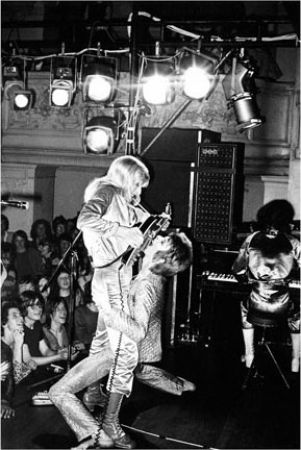 But all this was before the release of Ziggy Stardust. I think there were 400 people at the first concert I went to, then there were 500 and by the time he played Oxford Town Hall which was, I believe, 12 June, 1972, which was right around the release of Ziggy Stardust, there were actually 1,000 people. That’s were I did the shot of him munching away on Mick Ronson’s guitar and tenderly clutching his buttocks (pictured right).
But all this was before the release of Ziggy Stardust. I think there were 400 people at the first concert I went to, then there were 500 and by the time he played Oxford Town Hall which was, I believe, 12 June, 1972, which was right around the release of Ziggy Stardust, there were actually 1,000 people. That’s were I did the shot of him munching away on Mick Ronson’s guitar and tenderly clutching his buttocks (pictured right).
Obviously you couldn’t have had a clue that was going to happen.
Things went so fast, there was only a certain amount of discussion at the time, which was basically, “Did you get it?” The next day I went and processed the film, as I used to do in those days, and he [Bowie] got me to go up to his manager’s office. David knew what he was doing – he was super-sharp, super-bright, way ahead of where I was at in terms of understanding of what was going on, but the interesting thing about that shot was, it wasn’t by design. All David was trying to do – and he explained it to me many years later when we did the book, Moonage Daydream - was bite the guitar.
In fact in my book, you’ll see the shot and you’ll notice that David’s actually standing up but because of the way Mick swung the guitar, his feet are splayed – but he wasn’t on his knees, which is how that shot is generally perceived. But, when David saw the effect it had, of course he played up to it. He did that “I’m the girl and Mick’s the boy stuff,” although David, believe me, was very much in charge. But this was the day of the gay revolution so he was working it.
Maybe, but I think a lot of women also found it very attractive.
What? Did they ever? I mean, believe you me, I would slap on a bit of rouge and lip gloss and a bit of kohl round the eyes. If you wanted to get near the girls that were the most fun, you needed to look like a big poof.
You had no idea that the "guitar fellatio" opportunity was going to happen, but what about the picture you took of Lou Reed for Transformer? It looks like a studio shot.
It was actually taken during a concert at King's Cross Cinema but it was taken during a quiet moment of the performance and I’ve got the contact sheets to prove it. Mostly what I do now is set-up photography but in those days I would shoot anything, anywhere and I didn’t have much experience in the studio. That and the Raw Power [Iggy and the Stooges] cover (pictured below, 1972) were both shot at the same venue in July 1972 and it seems that they were shot a day apart, although I didn’t realise that until recently.
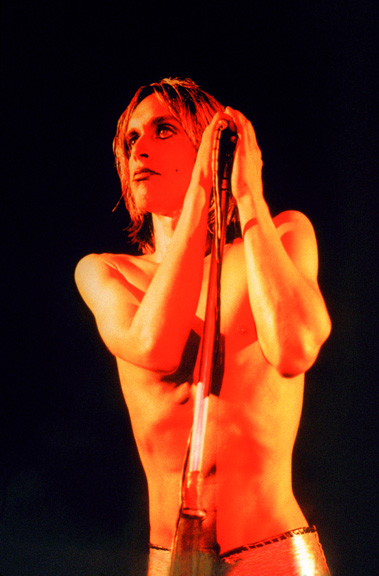 Iggy really looks like an iguana in the Raw Power shot which is of course where he gets the name from. The irony is that those two shots [Transformer and Raw Power covers] were taken when Lou and Iggy were relatively unknown, unless you were very, very hip, and neither of them had been able to sell any records. They were definitely underground characters but those two shots are the ones that somehow distilled and defined their image forever. Quite why these things happen, I don’t know. I’ve shot loads of pictures of both of them since then but those are the most famous shots of them to this day.
Iggy really looks like an iguana in the Raw Power shot which is of course where he gets the name from. The irony is that those two shots [Transformer and Raw Power covers] were taken when Lou and Iggy were relatively unknown, unless you were very, very hip, and neither of them had been able to sell any records. They were definitely underground characters but those two shots are the ones that somehow distilled and defined their image forever. Quite why these things happen, I don’t know. I’ve shot loads of pictures of both of them since then but those are the most famous shots of them to this day.
And then in that same period I took the one of David, Lou and Iggy at the Dorchester Hotel – the unholy trinity! It’s in the book and you’ll notice that there’s no scurrilous manager lurking around in the background. I wanted the book to have a bunch of stuff that’s never been out there before so I used a different shot.
Tell me about the Ziggy tour of America.
That was interesting for all of us. You’re talking about a lot of very young people running wild around America, not really quite sure what they were up to. I mean, I was there to take pictures, which of course I did. Not that I was getting paid - I had all my expenses covered but David’s manager at the time was a crafty bastard and I don’t think he hardly paid anyone, including David - but I did amass all these amazing pictures. At the time their value was very limited but of course nowadays, I’ve been offered a lot of money for them - not that anybody is going to wrench them from me.
So when did you start to earn some proper money?
Look, I was making enough money to scramble by. I wasn’t just shooting David or Lou or Iggy, there were other little bits and pieces. Mott the Hoople also came along that summer [1972], remember. The interesting thing is that David really did a rescue act [by producing their records] on Mott the Hoople, Lou Reed and Iggy Pop. The Mott had had two or three records out on Island Records that had been complete duds and were about to break up; the Velvet Underground hadn’t been able to give any records away and Lou’s first solo album hadn’t done anything so RCA were about to drop them and Iggy and the Stooges couldn’t get arrested.
Of course, the difference between Mott the Hoople, Lou Reed and Iggy Pop in those days was that the Mott had had a big hit, obviously, with "All the Young Dudes" and that got them rolling and Lou had a hit with "Walk on the Wild Side". You can hear David all over Transformer – well, David and Mick. Don’t underestimate Mick Ronson’s contribution, he was a great arranger and played the guitar and piano and would do the backing vocals along with David. And of course, to this day, it’s still Lou’s most successful album.
But Iggy didn’t even have a record deal so David’s manager hustled for a one-album deal with CBS and that became Raw Power, but as Iggy says in a video clip that I have from a session that we did about 20 months ago, three months after it was released, it was in the 50 cent bin. Now it’s regarded as one of the best albums of all time - with that picture of him looking like an iguana.
 Then Queen came through the door because they wanted a taste of glam. They were not well- known when I first met them, although there were about 700 or 800 people at the first gig of theirs I went to at Imperial College in 1973, so they had obviously established some kind of following.
Then Queen came through the door because they wanted a taste of glam. They were not well- known when I first met them, although there were about 700 or 800 people at the first gig of theirs I went to at Imperial College in 1973, so they had obviously established some kind of following.
Brian [May] and John [Deacon] were boffins. They were very studious characters. Roger [Taylor] of course trained to be a dentist and Freddie went to art college as did David Bowie and Syd Barrett and of course, all kinds of English rock'n’rollers – John Lennon, Pete Townshend and what have you. The English art colleges were very productive when it came to rock'n’roll.
So how did that very famous picture of Queen come about, the one that’s used on the cover of Queen II and was later adapted for the video of "Bohemian Rhapsody"?
I remember they [Queen] came to see me and they were very chipper, very chatty. Their brief was that they had to have a gatefold album cover – those were the days - it had to have a black-and-white theme and it had to feature the band. They played their record to me at that first meeting and I said, “Wow! Ziggy Stardust meets Led Zeppelin!” and they said, “Yes! Exactly!” and that seemed to seal the deal. I did those very camp, topless shots that are quite well known, and a bunch of other stuff during my first session with them and then I had another idea. Around that time I got to know a guy called John Kobal – do you know the Kobal collection [an archive of cinema photography]? He had this amazing collection of pictures of old Hollywood film stars that he’d rescued when the studios were throwing them out in the Sixties. I’d just shot a portrait of him for his new book, I can’t remember who it was on, but it might have been on Marlene Dietrich because he gave me a picture of Marlene Dietrich on the set of Shanghai Express.
Anyway, I showed it to Freddie and he knew exactly where I was coming from. Freddie was a very sweet guy, a very nice human being, but he was projecting way ahead of where the band were at that moment. He was very insistent that they were going to be a very big deal. During the session I shot lots of variations: I swapped John and Roger from left to right and we did white shots and black shots and for a while there was some discussion as to whether we should use a white shot or a black shot on the outside of the album cover although I don’t’ think for a moment there was any doubt in mine or Freddie’s mind what we should use.
That was another key moment but it just kept rolling on from there. I had a hell of a run in those days. If you look in the book you’ll see Ray Davies in New York, a promo shot of Jimmy Cliff for the release of The Harder They Come – I even shot a Cat Stevens album cover. I also shot all the Rocky Horror pictures, which doesn’t mean so much in England but it’s a massive cult film over here. And of course there was Roxy Music and a band called Cockney Rebel.
You mean the cover for Psychomodo?
I did several with Steve [Harley, lead singer of Cockney Rebel] but at that point it was the original line-up. Cockney Rebel and Queen were both signed to EMI but Cockney Rebel was very much Steve’s band so he was featured very strongly, whereas Queen was a democracy, except, as I discovered fairly early on, when it came to the visuals Freddie could normally get his way. He named the band and designed the logo – can you imagine how he got them to go along with that? “Oh – and by the way, we’re going to call ourselves Queen!” But he always managed to get them to go along with him and they turned out to be one of the most significant acts of all time and made some great music that still, to this day, sounds just terrific.
You were working extensively in both London and New York – why did you decide to move to New York permanently in 1977?
Well, I was in and out [of New York] in the late Seventies. I don’t know quite how to put this but it was something about the girls and the chemicals that sucked me in. I still had my place in London, right through until 1982, and I also had a wife, God bless her, a wonderful lady, but you can imagine, the cachet I had [in New York] just through my association with David, Lou and Iggy. And of course, that meant that all the sins that you could possibly imagine, they were all open and available to me and I kind of got sucked further and further into it and London became very boring to me, compared to New York. New York has got an energy to it - it’s partly because of the geographical concentration – I think that from 23rd Street down to Wall Street and over to the rivers on either side is the most concentrated energy-centre level in the entire universe. It teems with energy. I mean there’s a lot of energy in London but everything is very spread out.
So of course, when you went to New York you became involved with bands such as the Ramones, Talking Heads and Blondie.
Talking Heads were signed to the same label as the Ramones and the Dead Boys and I’d got to know the art director. He was English actually, his name was John Gillespie and I remember his story was that he started out working in a record store in London with Elton John before Elton broke out. So anyway, I shot a bunch of stuff for him, including Talking Heads. They were very different, very well educated of course - Rhode Island School of Design is where they emanated from.
Lou Reed took me to see them play in the autumn of 1976 - they were still a trio and I think they’d made an EP with "Psychokiller" on it, and then Jerry came in. He was the one that I certainly dabbled in certain arts with.
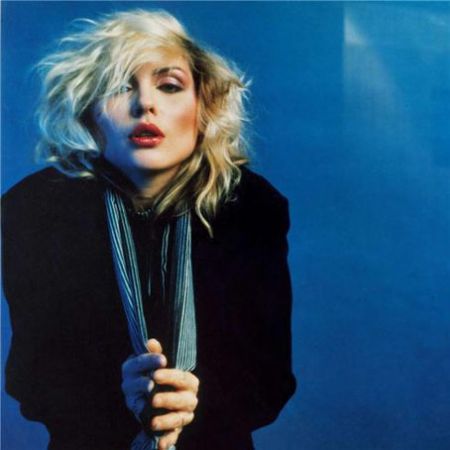 And this is also when your long association with Deborah Harry began.
And this is also when your long association with Deborah Harry began.
Therein lies an interesting tale in the sense that they were about to release Parallel Lines which had [the single] "Heart of Glass". They’d already had at least three Top 10 hits in England and they were just on the verge of breaking America - a lot of American bands used to go to England to break out and then they’d come back to America. There was a magazine called Viva, an American magazine, owned by the same guy that owned Penthouse magazine, Bob Guccione – I didn’t know him very well but I got to know his son Bobby Guccione Jnr and I remember a guy called Joe Brooks, who was his art director. Apparently he [Guccione] started off by doing stuff in the bathroom at Joe’s house! Funny how these things start from humble beginnings.
Anyway, I’d done a shoot with Debbie (pictured above) in the autumn of 1978 and they had an interview with her and they needed a few pictures for the inside of the magazine. However, before it could come out, the magazine folded. Then, about 15 months later, Debbie had become a big star – "Heart of Glass" had come out and they’d had a string of other hits and they decided they’d like Debbie on the cover of Penthouse – they’d already had Donna Summer and that had been very successful. So they used my pictures of Debbie – clothed in black right up to her neck! But I think it was the bestselling issue of 1980 – Debbie Harry doesn’t have to take her knickers off to look sexy. Her face alone does everything. She’s still a friend to this day. Got an email from her last week with a couple of kisses on it.
She is also quoted as saying, “Mick Rock is very tall and very handsome,” which must have put a spring in your step.
Yes. She also said that I’m quite mad. And the other line was “I think if Mick had been a drag queen, his name would have been Miss Direction.” I think she’s talking about my shooting, which is fairly energetic probably, by most people’s standards. I never saw myself as a voyeur. That’s not where I’m coming from, you know. I’m not a quiet photographer.
I think one of the qualities that makes your photographs particularly interesting is that you weren’t just a bystander, you were actually part of the scene.
That was what I knew. I wasn’t owned by anybody. My allegiance was always to the act. I wanted them to be happy. I wasn’t owned by a magazine, I wasn’t owned by a record label or anything at all, I was a free radical, as it were. And a very naughty boy to boot! I couldn’t help it!
There’s a book out there called Picture This which is a collection of pictures of Debbie and the band. You know, magazines only run three or four pictures at most from a photoshoot so all this stuff piles up over the years, although the great thing about that is that I’ve been able to do so many books because there’s always stuff people haven’t seen. But the nice thing about Exposed for me, is that it’s not just poofs and punks, which is what most people know me for. It embraces a broader turf - I put in some album covers that were not in fact the acts themselves – they were photographic but they were illustrative. There’s one I did for Fotomaker which is a close-up of little girl’s face, with a red background, which was nominated for a Grammy and another one for a Japanese band called Pinkeye. I dabbled around a bit with S&M for the cover of Strapps, which was for an English band on EMI records and there’s another one for an album called Wild Angel by Nelson Slater, which Lou Reed produced and created quite a lot of controversy.
 And I thought fuck'em. I thought I’m putting Lynyrd Skynyrd in – because that’s the last thing in the world people will think of - me and Lynyrd Skynyrd. And Gerry Garcia from the summer of 1972. But I also wanted to bring it up to date so there’s also Lady Gaga which was shot in 2008 before she broke out. I have a video tape where she informs me that she’s going to be one of the biggest acts in the world within the next few months and she wasn’t lying. And a more up-to-date one of her and Bono (pictured above).
And I thought fuck'em. I thought I’m putting Lynyrd Skynyrd in – because that’s the last thing in the world people will think of - me and Lynyrd Skynyrd. And Gerry Garcia from the summer of 1972. But I also wanted to bring it up to date so there’s also Lady Gaga which was shot in 2008 before she broke out. I have a video tape where she informs me that she’s going to be one of the biggest acts in the world within the next few months and she wasn’t lying. And a more up-to-date one of her and Bono (pictured above).
But now it must be different because the music scene is so different now and you’re not right in the thick of it now.
Yeah, but I have a lot of fun. I’m having a good time. I suppose I get a lot of room to manoeuvre because I walk in the door with a certain pedigree but now most of the people I work with are younger than me - the older ones tend to go out to pasture, although the picture of Bowie on the cover of the book was taken from 2002 (pictured below left) and there’s a picture of Iggy from 18 months ago.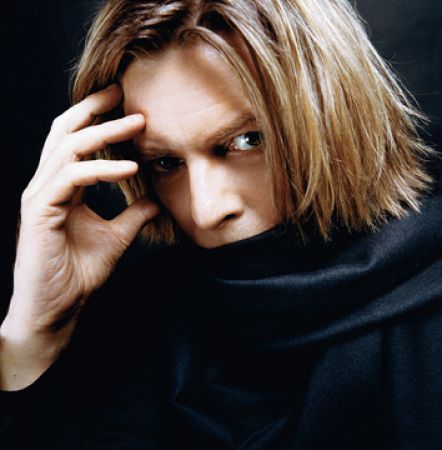 But people like Bowie and Iggy Pop don’t really go out to pasture do they? They just do different things.
But people like Bowie and Iggy Pop don’t really go out to pasture do they? They just do different things.
Well, yeah, I mean, that applies across the board, you have to understand. It’s about how long do you want to live? I mean either one is dead or one gets up in the morning and does exercises.
And what age do you get to when you decide that you’ve got to do that?
Well, I was forced to get very sensible in that area about 14 years ago. I dragged it out as long as I could, then I nearly died and I had to have a quadruple bypass. They cut me open and rewired me and I had a six-hour blood transfusion - they told me if I’d come in an hour later I’d have been dead. So that was an interesting experience - it certainly cleaned me up, there’s no doubt about that. I do a lot of yoga now and meditation and I get cracked and massaged all the time. I’m a massage addict - whenever I’m talking to Idea Generation [Rock’s PR company], the first thing I say is, “You’ve got to find me a massage therapist when I come to London because the six or seven days I’m there I know I’m going to need at least four massages." But when I shoot, it’s just as nutty. I suppose all the memory is in the nervous system.
There’s one little tiny thing I still do which is, you know, the obvious, but I’m not spelling it out, just in case my mum reads this. I don’t want to upset her at all. But you know, you can go to the same headspace [without drugs], you just have to work at it a bit. I do a 10-minute headstand every day, workout for an hour and then I do a meditation. I also have something called a light and sound machine, a brain machine that works on your alpha, beta, zeta and delta rhythms, so there’s many ways to pluck a turkey, it just took me a long time to figure it out.
But even when I was dancing the light fandango all those years I never really had a drinking habit and nor did I ever get seriously into the big nasty thing either - that was a no-no for me because I had friends die that way and anyway, I was only interested in things that took you up. Actually I knew about yoga and something about massage from quite an early age - I also used isolation tanks - but I would mix it in with some of these chemical indulgences and that put you in an interesting state of mind. I was an experimental gentleman, I kind of mixed it all up. I wouldn’t eat or sleep for three or four days and then I’d indulge - you know. I used to read a bit too much in my youth and I read about Rimbaud walking the streets of the East End of London without food for three or four days and taking opiates. I mean, I was full of all this stuff so my mind was contaminated by great artists. I didn’t study photography in any serious way and these were my influences - it worked out but at the same time, it put me on a path that could have killed me.
But now it’s great. I’m going to shoot Brian Ferry when I come to London, I’ve just shot a band called the Black Kings, I’ve got to go to Chicago next week to shoot R Kelly, I’m probably shooting Enrique Iglesias in December; so I’m shooting as much as I ever shot in my life. Somehow I got recycled.
Tell me about the Carly Simon session – she looks unusually vampish.
That session was for the cover of Come Upstairs. I don’t think I’d slept in a week when I did those pictures but Carly connected immediately with the mania of my energy and she delivered, she gave me these incredible pictures – she’s spitting champagne in some of them. No one had ever shot her like that before - I thought she looked wild and savage – but the record company didn’t know what to make of them.
 I also like the one of Ozzy Osbourne looking more like a poet than the Prince of Darkness.
I also like the one of Ozzy Osbourne looking more like a poet than the Prince of Darkness.
Well, I can make anyone look like a poof or a poet - even Ozzy Osbourne (pictured right, 1975). But he was quite cute in truth. Kelly is also in the book because I shot her for Sony Records - she’s a friend of mine, in fact, and she told me that that’s by far her favourite session of her dad. I’m sure it’s because he looks pretty. You could take him home and smack his bottom.
And then there’s one of Phil Collins with hair and one of Peter Gabriel looking like a complete looney - I know Peter loves those pictures - those were the days when he had the kind of reverse Mohican. He’s in the book a couple of times. There’s also a shot of a young lady in here called Riley Keogh and she says of it, “Well, I never looked more like Elvis than I did in the pictures that you took of me,” and she is, of course, Elvis Presley’s granddaughter. It’s opposite a photograph of my daughter when she was four wearing an Elvis Presley dress purchased at Trash and Vaudeville, the great rock'n’roll store that still exists in the East Village in New York.
 Anyway, I think I’ve done what I needed to do before I can move on although I know people are clamouring for me to do a Lou Reed book- there’s a great picture in the book of him buying a puppy (pictured left, 1976) - and I may, if Lou will come on board and give me his blessing. But he’s an unpredictable character.
Anyway, I think I’ve done what I needed to do before I can move on although I know people are clamouring for me to do a Lou Reed book- there’s a great picture in the book of him buying a puppy (pictured left, 1976) - and I may, if Lou will come on board and give me his blessing. But he’s an unpredictable character.
But I was able to get away with all sorts of bits and pieces in this book of unlikely things. I wanted to be able to show people that it wasn’t just poofs and punks, my range was much broader. I don’t know if you’re aware of it, but I also dabble in art as well, in kind of collage work. There’s some work up on my website called Rip Art and the very last image in the book is actually one of my David Bowie collages and I snuck it in, right at the end. I thought, I’m going to get this in somewhere because I’m going to start doing exhibitions of my collages.
I also sneaked in a picture of my cat Kabuki on the credit page. He’s a beautiful cat. Bob Gruen [the photographer] told me that there are more cat pictures downloaded on the internet than pornography. I think I’m going to do a bloody cat book next time.




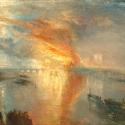

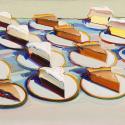

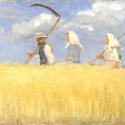

![SEX MONEY RACE RELIGION [2016] by Gilbert and George. Installation shot of Gilbert & George 21ST CENTURY PICTURES Hayward Gallery](/sites/default/files/styles/thumbnail_125_x_125_/public/mastimages/Gilbert%20%26%20George_%2021ST%20CENTURY%20PICTURES.%20SEX%20MONEY%20RACE%20RELIGION%20%5B2016%5D.%20Photo_%20Mark%20Blower.%20Courtesy%20of%20the%20Gilbert%20%26%20George%20and%20the%20Hayward%20Gallery._0.jpg?itok=3oW-Y84i)




Add comment